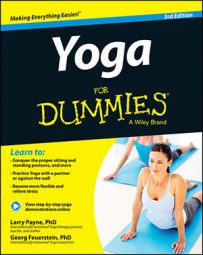In Hatha Yoga, breathing is just as important as the postures. How you breathe when you’re moving into, holding, or moving out of any given posture can greatly increase the efficiency and benefits of your practice. Think of the breath as mileage plus. The more you use breathing consciously, the more mileage you gain for your health and longevity. Consider some basic guidelines:
Let the breath surround the movement. The breath leads the movement by a couple of moments — that is, you initiate breathing (both inhalation and exhalation) and then you make the movement. When you inhale, the body opens or expands, and when you exhale, the body folds or contracts.
Both the inhalation and the exhalation end with a natural pause.
In the beginning, let the breath dictate the length of the postural movement. For example, if you’re raising your arms as you inhale and you run out of breath before you reach your goal, just pause your breathing for a moment and bring your arms back down as you exhale. With practice, your breath will gradually get longer.
Let the breath itself be your teacher. When your breath sounds labored, you need to back off or come out of a posture.
Try to visualize the breath flowing into the area you’re working with in any given posture.
Breathing in four directions
You can move your body in four natural directions:
Flexion: Bending forward
Extension: Bending backward
Lateral flexion: Bending sideways
Rotation: Twisting your body
Normally, when people move, they tend to hold or strain their breath. In Yoga, you simply follow the natural flow of the breath. As a rule, adopt this pattern:
Inhale when moving into back bends.
Exhale when moving into forward bends.
Exhale when moving into side bends.
Exhale when moving into twists.
![[Credit: Photograph by Adam Latham]](https://www.dummies.com/wp-content/uploads/431533.image0.jpg) Credit: Photograph by Adam Latham
Credit: Photograph by Adam Latham
Recognizing the distinct roles of movement and holding in Yoga postures
Most Yoga books talk about stationary or held Yoga postures (asanas). Before you try to hold a posture, you first become acquainted with moving in and out of most of simple postures, following the rules of breath and movement. When you can move in and out of a given posture easily and confidently, try holding the posture for a short period without holding or straining your breath.
You know you’re straining when your face turns into a grimace or you feel it going red like a tomato. Getting a handle on moving into and out of the postures before adding the element of holding is important for three reasons:
It helps prepare your muscles and joints by bringing circulation to the area. It’s like juicing up your joints, which adds a safety factor.
It helps you experience the intimate connection among body, breath, and mind.
In the case of stretching postures, moving into and out of a given posture before holding the posture supports the concept of proprioceptive neuromuscular facilitation (PNF). If you tighten a muscle before stretching it, either by gentle resistance (isotonic) or by pushing against a fixed force (isometric), the subsequent stretch is deeper. Scientific research supports this phenomenon; physical therapy texts refer to it as PNF.

